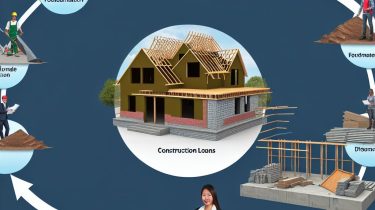How construction loans work for building a home.

Understanding Construction Loans
A construction loan is a short-term, interim financing solution that serves a crucial role in the journey of building a home. It covers the costs associated with the construction process, paving the way to secure a traditional mortgage once the building is complete. Unlike conventional loans, construction loans pose a higher risk for lenders primarily because the collateral, which is the building itself, is not yet constructed. Consequently, they often come with higher interest rates and specific, stringent requirements. This article delves into the essence of construction loans, exploring their types, application process, disbursement methods, terms, conditions, and the potential challenges they entail.
Types of Construction Loans
Understanding the available types of construction loans is essential for making informed financial decisions. Below are the two primary types of construction loans, each designed for distinct financial preferences and project scopes:
1. Construction-to-Permanent Loan: Often favored by homebuilders, this loan offers a comprehensive funding solution. Initially, it functions as a construction loan to cover all the building expenses. Once the construction is completed, it seamlessly transitions into a mortgage for the homeowner. One of the primary advantages of a construction-to-permanent loan is the single closing, reducing the overall closing costs associated with separate loans. This streamlines the process and frees the borrower from dealing with numerous transactions.
2. Stand-Alone Construction Loan: This loan type serves exclusively for the construction phase, requiring a separate mortgage upon project completion to refinance the initial debt. Borrowers who hold substantial cash reserves and prefer to keep construction and permanent financing separate might find this approach appealing. It offers flexibility, allowing the borrower to shop for a potentially better mortgage deal after the construction concludes.
The Application Process
Securing a construction loan involves a more intricate process compared to obtaining a standard mortgage. The following steps provide an overview of the essential actions involved:
Pre-Approval: The journey begins with getting pre-approved before breaking ground. This stage involves a thorough assessment by the lender of the borrower’s creditworthiness, employment stability, and income levels. Prospective borrowers must present detailed construction plans and a comprehensive timeline, which the lender will review to determine eligibility.
Choosing a Builder: Selecting a reputable and licensed builder is a critical requirement from the lender’s perspective. Lenders often request proof of a builder’s credentials, including licenses and insurance. The builder typically provides a package detailing their experience and reliability, assuring the lender of their professional capability.
Preparing a Budget: Crafting a detailed budget is a vital step, encompassing all construction-related expenses. This includes labor costs, material expenses, necessary permits, and any other foreseeable expenditures. Lenders meticulously examine this budget to verify its accuracy and completeness, ensuring it aligns with the project’s scope.
How Disbursements Work
The disbursement method for construction loans differs significantly from traditional loans. Instead of releasing the full amount upfront, funds are disbursed in increments as the project progresses through predetermined phases. This phased funding, often referred to as “draws,” aligns with the construction timeline and is contingent upon completing specific milestones. A predetermined draw schedule is imperative to dictate when funds are released. Typically, site inspections accompany each draw to verify that the project is on track and consistent with the original plan, safeguarding the lender’s investment.
Loan Terms and Conditions
The terms and conditions of construction loans are distinctive, typically ranging from six months to two years. During the construction phase, borrowers generally make interest-only payments. Upon completion of the project and issuance of a certificate of occupancy, the loan transitions into a permanent mortgage for those who opted for a construction-to-permanent loan. Several factors contribute to determining the specific terms and conditions of a construction loan. These include the borrower’s financial status and credit history, the loan-to-value ratio, and the overall scope and complexity of the project. By evaluating these elements, lenders aim to mitigate potential risks.
Potential Challenges
Embarking on a construction project with a loan involves navigating several potential challenges:
Project Delays: Construction projects are susceptible to delays caused by various unforeseen circumstances. Such delays can extend the loan term, incurring additional costs for the borrower.
Cost Overruns: Building projects frequently exceed the initial budgeted costs, which necessitates careful financial planning and maintaining adequate financial reserves to cover unexpected expenses.
Interest Rate Fluctuations: As construction loans typically feature variable interest rates and are relatively short-term, borrowers are exposed to potential hikes in interest rates during the construction period, potentially increasing financial burdens.
A fundamental understanding of these elements is vital for effective planning and risk management in a construction project. Ensuring proactive management and seeking professional advice can significantly enhance the chances of a smooth, successful building experience. Should you require further insights or guidance on securing a construction loan, it is advisable to consult with a financial advisor or a loan officer experienced in the domain of construction financing.
This article was last updated on: May 12, 2025